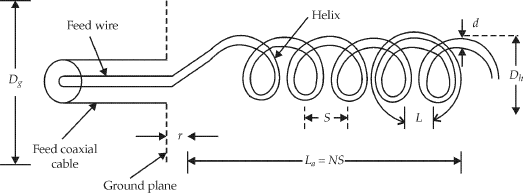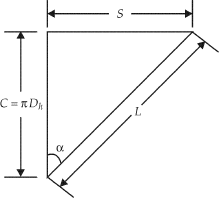Helical antenna is an antenna which has a helix or spring shape. Its polarisation and radiation properties depend on the diameter, pitch, number of turns, wavelength, excitation and spacing between the helical loops.
Table of Contents
Helix Antenn Design and Construction Details
A typical structure of helical antenna is shown in

It consists of helical loops made of a thick conductor which have the appearance of a screw thread. It is associated with a ground plane made of the conductor. The ground plane is often made of screen or sheet or of radial and concentric conductors. This antenna is fed by a coaxial cable. This can be operated in normal and axial modes. The common antenna parameters are:
C = circumference of helix
α = pitch angle
S = loop separation
La = axial length = NR
N = number of turns
L = length of one turn
r = distance between ground plane and helix proper
d = diameter of helix conductor
The inter relations between the parameters are


Radiation Modes of Helical Antenna
There is 2 modes of operation –
- Normal Mode
- Axial Mode
Normal Mode
In normal mode, the radiation is maximum in the broadside direction. This can be called broadside mode. This mode happens if NL << λ, that is, the dimensions of the helix are small. In this, beam width is small and efficiency is low. These two parameters can be increased if the helix is large.
Axial ratio for elliptical polarisation is given by

If AR = 0, elliptical polarisation becomes linear horizontal polarisation.
If AR = ∞, elliptical polarisation becomes vertical linear polarisation.
If AR = 1, elliptical polarisation becomes circular polarisation.
Hence, for circular polarisation,


The normal mode is not used because of small bandwidth and low efficiency.
Axial Mode
In axial mode, radiation is maximum along the axis of the helix. It can be considered as end-fire mode. In this mode, polarisation is almost circular. This mode can be obtained when Dh and S are of the order of λ. Circular polarisation occurs when C/ λ = 1 and S = λ/4
The ground plane is of λ/2 diameter. The radiation patterns in normal and axial modes.

In axial mode, the terminal impedance of helix is about 100 to 200 Ω.
Salient features of helical antenna
- Helical antenna is a simple antenna for circular polarisation.
- It is used in VHF and UHF bands.
- It is most popularly used in axial mode.
- In normal mode, beam width and efficiency are small.
- It is a wide band antenna in axial mode.
- It is used for extra-terrestrial communications, satellites and space probe communications, radio astronomy and so on.
- It is not preferred in normal mode.
- If axial ratio, AR = 0, linear horizontal polarisation results.
- If AR = ∞, linear vertical polarisation results.
- If AR = 1, circular polarisation results.
- It is simple in construction and has high directivity.
Applications of helical antenna
- It became the workhouse of space communications for telephone, television, and data, being employed both on satellites and at ground stations.
- Many satellites including weather satellites, data relay satellites all have helical antennas.
- It is on many other probes of planets and comets, including moon and mars, being used alone, in arrays or as feeds for parabolic reflectors, its circular polarization and high-gain and simplicity making it effective for space application.
- It is used to transmit and receive VHF waves for ionospheric propagation.
- It is used for the following communications:
- Satellite, space communications.
- Space telemetry at HF and VHF bands
- Radio astronomy.




